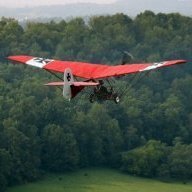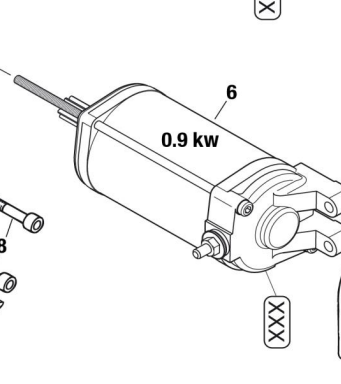-
Posts
1,885 -
Joined
-
Last visited
-
Days Won
18
Content Type
Profiles
Forums
Gallery
Downloads
Blogs
Events
Store
Aircraft
Resources
Tutorials
Articles
Classifieds
Movies
Books
Community Map
Quizzes
Videos Directory
Posts posted by danny_galaga
-
-
I'm nearly at the end of my paperwork. But also at the end of my tether. I've supplied an invoice for my prop, but because they haven't heard of that brand need more info. This is the manufacturer:
My invoice has a serial number and prop size. Makes me laugh about the thread for making your own propeller since it seems it's not legit if ra Aus have never heard of it 🙄
I've half a mind to sell my prop as a decoration and buy a Sensenich. Wonder if ra Aus are familiar with that little cottage business...
-
 1
1
-
-
No interference in taxiing at any rate. I haven't flown with it yet. I think if it needs suppression, it's all ready built in. Like most things automotive.
The capacitor on the other regulator seems to me to be a kludge. I feel the Ducati reg/rec is just not very well designed, and of course it's designed for motorcycles, where radio suppression isn't as critical. It must need some you'd think because otherwise you are causing interference in people's cars and houses as you pass.
There are some avionics guys here who can elaborate on the more technical matters, but the upshot is the Dutch reg/reg was designed for aircraft and so doesn't need the external capacitor. PLUS as you noticed, needs less wires. AND can't drain your battery just sitting there 🙂
It's the only aftermarket parts I've bought so far that was probably MORE expensive than the original. But well worth it just for the simpler and more efficient operation 😊
-
 1
1
-
-
13 hours ago, Underwood said:
Hello Danny, I just bought a Carmo Reg/rec and notice the wiring diagram omits a capacitor, did you fit one anyway?
Nope..it's a different design. It doesn't need it.
-
19 hours ago, onetrack said:
Skippy, here you go, from our finest quality aircraft parts supplier...... 😄
Being the Xmas month, and the fact AliExpress sellers use any old fly by night couriers at the receiver end, you should get it by early February if you order now 😄
-
 1
1
-
-
1 hour ago, facthunter said:
Just get the zonshen part using the Rotax Pn.. Nev
That's the way!
-
 1
1
-
-
9 hours ago, onetrack said:
What a joke, talk about rort of the century! Just eight cup-shaped rubber pads and eight cupped, pressed washers. They're worth about $200 in total.
See a rubber mount manufacturer, they will more than likely be able to knock them up for you.
There's nothing special about the mountings, they're as simple as they come. Their correct technical name is centre fixing isolators, have a chat to Mackay Industrial (Derwent Industries).
The main thing that needs to be established is the Duro (Durometer measure) grade of the rubber. The Duro governs the rubber hardness/softness and it's important the correct Duro is used for the application. Too soft and the rubber will chew out, too hard and too much vibration is transferred to the frame/fuselage/chassis.
 06. Centre Fixing Isolators – Derwent Industries
DERWENTINDUSTRIES.COM.AU
06. Centre Fixing Isolators – Derwent Industries
DERWENTINDUSTRIES.COM.AUThese look a hell of a lot like the ones on the Bushcat
-
 1
1
-
-
Errol is a very industrious person, so I think he'll make a good fist of it. From his unique perspective his team can iron out the QA issues of the kit. The plane itself is a good plane.
Regarding my build, I had a lot of trouble with it, but I'm easily disappointed and offput. If it was a much cheaper project (I've made a couple of arcade machines for instance) that wasn't working out, it probably would have ended out the front for hard rubbish collection. But because it's an expensive undertaking, I had to persist. Every other builder, of this or any other plane has just knuckled down and got on with it.
Anyway, mine will be inspected next week. Might be one of the last South African versions to be completed.
-
 4
4
-
 1
1
-
 1
1
-
-
Just occurred to me that if the Orange Guy stays true to his promise of 60% tariff on Chinese made goods, that'll kill their US market.
-
 2
2
-
 2
2
-
-
2 hours ago, onetrack said:
But the only requirement for a military drone, is that the engine be reliable enough - and cheap enough - to last just one mission!
Bit of a difference to expecting your aircraft engine to perform 100% reliably for 2000 hrs, until overhaul!
SURVEILLANCE drones. They notch up thousands of hours very quickly. I'm not THAT daft that I think an engine design to last three hours is something to consider for a passenger plane 😄
-
 2
2
-
-
I think it was discussed in another thread that some Canadians and Americans have been trying these engines. I used to be a neighsayer regarding these engines but I'm only hearing good things about them mechanically. Price is another matter
I think I also pointed out in a different thread that a pretty good indication these engines are A grade is that they are supplied to the Chinese military for surveillance drones. If there's one customer you don't want to upset, it's the Chinese military 😄.
-
 1
1
-
-
On 14/11/2024 at 4:54 PM, Marty_d said:
one piece wooden wing.
😲
-
On 03/11/2024 at 9:30 AM, facthunter said:
TIME is important too.. Nev
Which is why this list can help. Except when it goes off the rails of course 😄
-
 4
4
-
-
On 25/09/2024 at 9:28 AM, RFguy said:
+spare parts list- spark plug wrench to fix fouled plug
That's something for your 'away' tool kit. There's nothing special about an NGK spark plug that you have to find cheaper alternatives or workarounds 😄
-
On 12/10/2024 at 5:58 PM, facthunter said:
We are all different. Everybody should be welcome unless they are deliberately being RS.. to act against the Interests of the forum at large. It's Ian's Baby. Nev
-
 1
1
-
 1
1
-
-
On 14/10/2024 at 9:04 PM, BrendAn said:
when we are doing preflight checks we always switch to atis and put in the latest qnh .
if you are flying out of the same place all the time why not just turn the altimeter to the known height, like outside our hangar it is 130 ft asl.
wouldn't that be the same result as the atis advice or am i thinking this wrong.
Its what ive always done with ultralights. In fact it's probably more accurate if you know your current elevation since that doesn't change from hour to hour, whilst the air pressure might.
In my case the airfield elevation is different from one end to the other so I have to be mindful of that. I think it's maybe 30 feet difference. Not a disaster if you get that wrong but it pays to be as accurate as possible in general, doesn't it?
Edit: I'm thinking of circuits and local area mind you.
-
 2
2
-
-
Do I have to 'unfollow' my own thread now...
-
 1
1
-
-
-
Fact Hunter, there's a lot to scroll through, can you describe in simple terms what this pin is doing, and what it goes in to? When I had my 912 starter out, I noticed nothing remarkable about it except that is a Denso motorcycle starter motor. I don't specifically remember a pin somewhere, but I wasn't looking for one either.
-
 1
1
-
-
On 11/10/2024 at 6:03 PM, onetrack said:
I can't, despite going through the whole thread and all the links carefully. I've never seen a starter shaft with a pin in the end - a circlip groove and circlip, yes - but never a pin. However, I'm always open to being proved wrong, and just as you think you've seen it all, some engineer decides it has to be done differently.
I'm quite confused now too. Are we still talking about the 912 starter? That just has a splined armature shaft. If we are talking about the sprag clutch inside the engine, I have no idea.. maybe there's a pin in that somewhere 🤔
-
 1
1
-
-
2 hours ago, facthunter said:
Cantilevered small dia drive shafts are not a good design. Nev
But good enough..you see them on Lucas and Delco car starters
-
5 hours ago, facthunter said:
You need to know if the LATER one goes straight on. IF everything's correct no problem. Get it working and FLY. You don't live forever. Nev
This is a different matter, I think we covered it before. The later starter is an upgrade, it replaces all 912 starters.
-
21 hours ago, facthunter said:
I've made my point and the image was amongst those posted here.. I wouldn't even "up" the starter torque. The mechanism isn't without it's problems, already.. You'd have to be voiding the engines certification. Nev
Dunno if anyone is talking about that. Rotax themselves upped it to 0.9kw I think. That later starter is all you need.
-
It's definitely Denso, and pretty much down to one or two models. Just the question of rotation. Surely someone must have a loose Rotax starter they can chuck some jumper leads on?
-
 1
1
-
-
Also, I've lost interest in the whole thing. I doubt I'll own my plane long enough for there to be any problems
-
 2
2
-





What specific info does Ra Aus need for propellers?
in Engines and Props
Posted · Edited by danny_galaga
Kit plane.. doesn't come with an engine or propeller. Surely whatever you fit, it is the correct propeller?